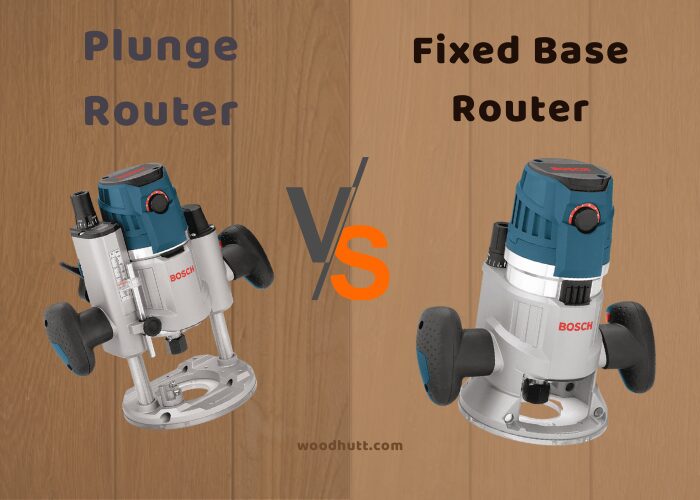Furnish your woodworking shop with a perfect router that will enhance your carpentry skills and improve your work. In general, there are two main kinds of routers:
Plunge router vs Fixed base router. Both types of routing machines are best performing and convenient if appropriately used. But you have to decide which suits you the most based on your experience level.
What We Have Covered
What’s the Difference Between Plunge and Fixed Base Router
Don’t sweat it! I have picked the good and bad about both types of routers. By the end of this article, you’ll understand which routers are ideal for you by knowing the comparison!
Before discussing the differences, let me start with the simple definitions of both routers:
A Plunge Router – Definition
A Plunge Router device comes with an adjustable design that permits woodworkers to regulate the height according to their task. The bottom of the plunge router stays uniform at the surface of your working material, which can be wood, fence, plastic, or metal.
It can be set from the middle of the material, far from the corner, making it unique compared to other router types.
A Fixed Base Router – Definition
A Fixed Base router is also called a conventional or regular router, primarily used at woodworking shops.
These routers feature a fixed base design which will not allow working at alternate heights. It needs to be fixed before you start your work and save the user’s extra effort in between.
Difference Between A Plunge Router and A Fixed Base Router
The main element which makes both router types different from each other is the base. If you have good woodworking skills, then the performance of both router types is appreciable.
Over that, some other factors like price, versatility, etc., make these routers unique. So let’s discuss them all one by one!
Design
The significant difference between plunge routers and fixed base routers is the design. The cutting bit is housed or engraved inside the routing machine in plunge routers, and depth is not constant.
Convenience
The fixed base routers are easy to operate and feature compact and lightweight structures because these are based on an old-school design that requires no advanced system or rocket science to run.
You can carry these routers to the site as well. At the same time, the plunge routers are advanced. So if you’re an entry-level woodworker, then it might be difficult for you to run a plunge router.
Power
The power or horsepower rating refers to the power generated by any router. It is an imperative parameter to consider while buying a routing tool. In my experience, both router types are consequential if appropriately used.
Besides, the power variation comes in router models. You should purchase a router that has at least 2HP or greater to complete your tasks efficiently.
Performance
The plunge routers allow users to start woodwork, for example, editing, cutting, veining, grooving, or shaping, from the middle of the material. It resultantly gives more control and grip over the material.
Price
As I said earlier, the plunge routers are more modern than fixed-base routers and give off more features. That’s why the plunge routers are more expensive than the fixed base routers.
So, if you’re tight on budget, then you should go for a fixed base router.
Versatility
The plunge routers support broad working experience because it offers adjustable height. This makes these routers more versatile than others. With the flip of a coin, fixed base routers have their applications but can’t perform extraordinary tasks like knob edge working, etc.
Experience Level
To run a plunge router, you need to have a basic knowledge of woodworking at least. Otherwise, you will end up having a mess. On the other hand, the fixed plate routers are flawless for newbies. You don’t need to have any experience before you start. It would be correct to say that fixed plate routers are perfect to learn routing from zero.
FAQs
What is the advantage of a plunge router?
Plunge router offers changeable depth or height at any point during work. It supports better handling and grip over the material as compared to other routers. Also, plunge routers are proven as more protective than primeval routers.
How deep can a plunge router cut?
As I said earlier, the plunge routers allow you to change height at times. But, how much? There is no constant answer because the figure varies in different router models. Regularly, the plunge routers come with a depth of 2 to 3.5 inches.
Is a router lift necessary?
I must say that it’s a myth! A router lift is not necessary for the betterment of the routing experience. Mostly, the router combo kits come with an adjusting knob that helps you in making minor adjustments in-depth—for example, the PC 7518 router combo kit.
Are router lifts universal?
Mostly, the fixed base routers feature universal attachment systems, that is, JessEm Mast R Lift II 02120 router lift. It also offers a bearing system that offers height regularity. In short, the router lifts are universal and durable, regardless of any brand or model.
Final Note
In the end, I have to say that a compatible router can improve your woodworking experience. Thus, it is necessary to have the right one! If you’re a professional worker and have a loose budget range, you should go for a plunge router.
In contrast, if you’re a beginner or need a cost-effective item, then consider the fixed base router. Hopefully, this information will be enough for your better understanding!
Happy Routing!



